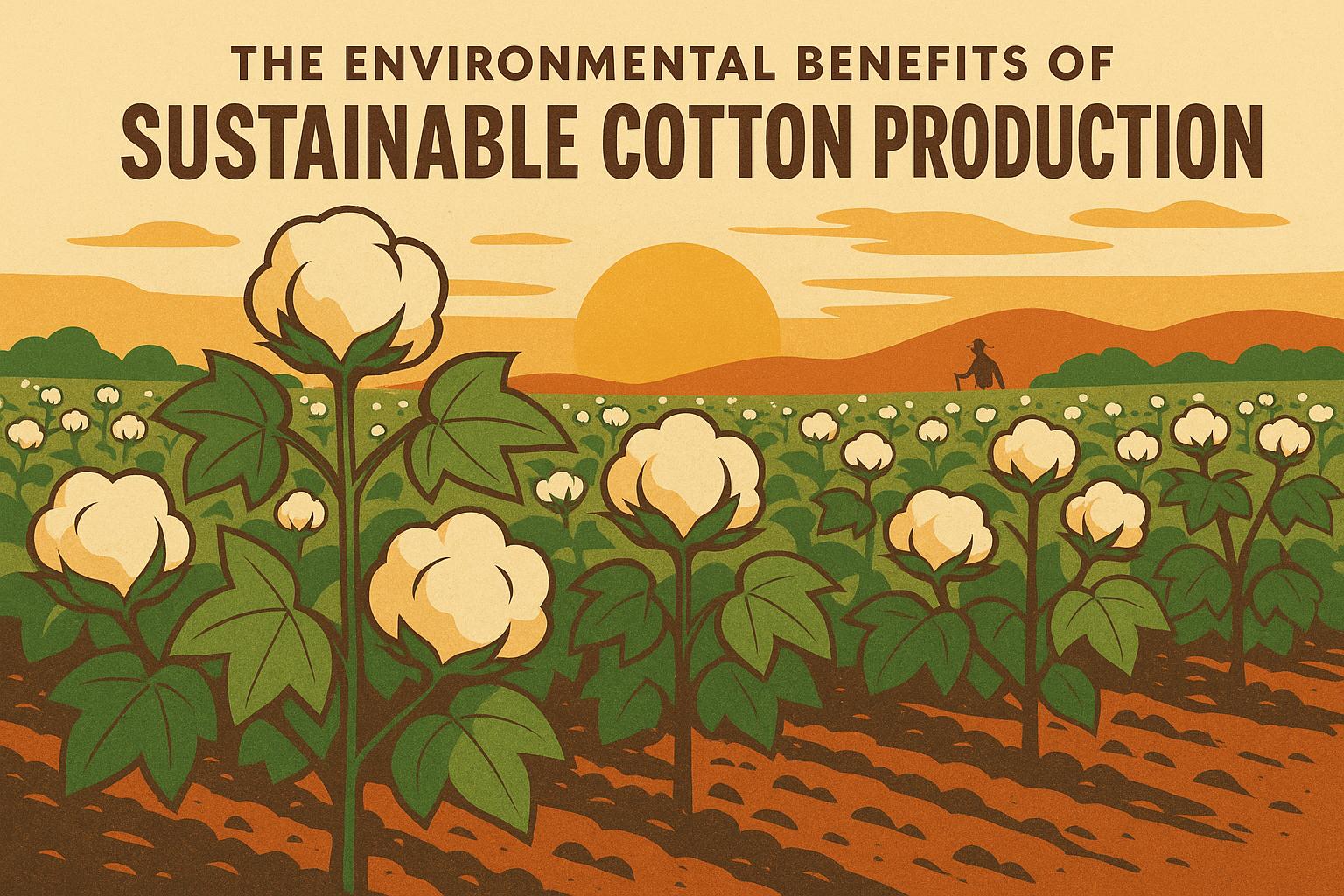Cotton gins are crucial for rural economic growth in the U.S., creating jobs, improving infrastructure, and supporting local businesses. Here's the big picture:
- Economic Impact: In Oklahoma, the cotton industry generated $284 million in 2021, supporting 4,170 jobs and contributing $565.7 million in economic output.
- Job Creation: For every 10 jobs in cotton production, 8 additional jobs are created in related sectors like transportation, chemicals, and equipment rental.
- Global Reach: The U.S. supplies 35% of the world’s cotton exports, making cotton gins vital for international trade.
- Infrastructure Development: Projects like the Altus Economic Loop in Oklahoma improve transportation efficiency and foster community growth.
- Success Stories: Facilities like Bogue Chitto Cotton Gin in Mississippi have boosted local production from 30,000 to over 100,000 bales annually, injecting millions into the local economy.
Cotton gins are more than processing facilities - they drive job growth, enhance trade, and build stronger communities.
Cotton Gins: From Past to Present
Manual Cotton Processing Before 1793
Before the advent of mechanical cotton gins, processing cotton was an exhausting and time-consuming task. Workers had to separate fibers from seeds by hand, and the effort only yielded one pound of cotton per day per person. This slow pace severely limited production and pushed many farmers to focus on crops like tobacco and rice instead. Long-staple cotton, though prized for its quality, was too expensive and difficult to process. These limitations stifled agricultural growth and economic potential, paving the way for a revolutionary change.
Eli Whitney's Cotton Gin Impact
In 1793, Eli Whitney introduced the cotton gin, a game-changing invention that revolutionized cotton production. This machine could process 50 pounds of cotton per day, a staggering 50 times more than manual labor. The impact on the Southern economy was transformative, as shown by the dramatic rise in cotton production:
| Year | Annual Cotton Production | Notable Impact |
|---|---|---|
| 1790 | 3,000 bales | Focused on sea-island cotton |
| 1820 | 335,000 bales | Inland cotton farming expanded |
| 1840 | 1,438,000 bales | Economic influence grew |
| 1860 | 3.8 million bales | Supplied 75% of the world's cotton |
The cotton gin didn’t just boost efficiency - it reshaped the entire economic framework of the South. As William H. Phillips from the University of South Carolina observed:
"The cotton gin developed by Eli Whitney in 1793 marked a major turning point in the economic history of the Southern United States."
Its impact went far beyond agriculture. The cotton gin spurred:
- Expansion of cotton farming into inland regions, making short-staple cotton a viable crop
- Industrial growth in Northern states, which relied on Southern cotton for manufacturing
- Development of transportation networks like railroads and steamships to support the booming cotton trade
- New economic opportunities across various industries
This invention not only transformed how cotton was processed but also laid the groundwork for broader economic shifts across the nation.
How Cotton Gins Build Local Economies
Employment Growth in Rural Areas
Cotton gins play a big role in creating jobs across various skill levels, especially in rural areas. Typically, about 80% of the work involves manual labor, while the remaining 20% focuses on operating equipment.
Recent examples highlight how these operations generate employment. Taylor Gin, Inc., based in Gould, Arkansas, announced openings for nine workers to assist during the cotton season from September 9, 2024, to February 1, 2025. Similarly, Woodville Gin, LLC in Lewiston, North Carolina, was looking to hire a helper-mechanic for the period between June 1, 2024, and December 31, 2024.
The variety of roles available includes equipment operation, maintenance, quality control, loading and unloading, management, and marketing. These jobs not only provide direct employment but also stimulate other areas of local commerce, creating a ripple effect throughout the community.
Local Business and Trade Effects
Cotton gins also fuel local economies by boosting trade and supporting business development. The U.S. cotton industry, which supplies about 35% of the world’s cotton exports, relies on a network of related industries like transportation, warehousing, and equipment manufacturing. These industries, in turn, strengthen local economies.
"Reduced production from this year's cotton crop not only means bad news for farmers, but it also impacts the local economies that rely on cotton. A smaller cotton crop means downstream users - gins, warehouses and shippers - will oversee and process less cotton. That's a loss of economic activity." - Brant Wilbourn, Texas Farm Bureau Associate Director of Commodity and Regulatory Activities
This interconnected system demonstrates how cotton production links directly to the financial health of local businesses and services.
Local Infrastructure Improvements
In addition to job creation and trade, cotton gins contribute to improving local infrastructure. They often act as central hubs, encouraging community development and streamlining trade. For example, the Oklahoma Cotton Council proposed the Altus Economic Loop Project in Oklahoma to establish a dedicated railroad loop system. This project aims to make cotton transportation more efficient and cost-effective.
Better road networks and enhanced railroad systems in areas with cotton gins not only improve the movement of goods but also foster broader community growth. These infrastructure upgrades serve as long-term investments, benefiting both the cotton industry and the surrounding areas.
Cotton Gin Success Stories
Local Economic Growth Examples
Cotton gins have played a key role in boosting local economies across the U.S. Take Mississippi's Noxubee and Lowndes counties, for example. Since its establishment in 2012, the Bogue Chitto Cotton Gin has been a game-changer for local agriculture. Started by a group of about two dozen farmers, this facility has significantly increased cotton production in the area. Over the years, annual production has skyrocketed from 30,000 bales to more than 100,000 bales. Altogether, the gin has processed over 800,000 bales, creating a ripple effect that has energized the local economy.
"It's been a real shot in the arm for our community. I would even say that the cotton crop in our area has become a favorite child."
- Aaron Litwiller, General Manager, Bogue Chitto Cotton Gin
The numbers below offer a closer look at the economic boost brought by the gin.
Economic Impact Numbers
The table below outlines some of the key economic contributions of the Bogue Chitto Cotton Gin:
| Impact Category | Metric | Example |
|---|---|---|
| Employment | Seasonal Jobs | Bogue Chitto Cotton Gin employs 30 workers during each harvest season. |
| Production Growth | Annual Output | Cotton production jumped from 30,000 to over 100,000 bales annually. |
| Economic Investment | Seasonal Spending | Over $5 million spent locally each season, fueling community businesses. |
These figures highlight the substantial role cotton gins like Bogue Chitto play in transforming agricultural communities and driving local prosperity.
Using cottongins.org

Finding Local Cotton Gins
cottongins.org provides an easy-to-use directory of cotton gins across the United States, complete with detailed listings that include addresses and contact details. This makes it simple for users to find nearby processing facilities, helping reduce transportation costs and improve operational efficiency, whether you're working within a single county or across state lines.
The platform's search tool allows users to quickly locate cotton gins in their area, which is especially helpful in rural regions where traditional networking options might be limited. Industry data highlights how platforms like this break down geographical barriers, making it easier for agricultural businesses to expand their market reach. By offering this centralized resource, cottongins.org not only improves logistics but also boosts visibility for businesses within the cotton industry.
Business Promotion Options
cottongins.org isn’t just about finding cotton gins - it also offers businesses opportunities to promote themselves and grow their presence in the industry. With sponsorship options tailored to different budgets and needs, companies can choose the level of visibility that works best for them:
| Sponsorship Type | Investment | Benefits |
|---|---|---|
| Sponsored Post | $200 per post | - Featured placement for 24 hours - Social media promotion - Permanent archive presence |
| Official Sponsor | $200 monthly | - Footer placement - Dedicated page listing - Free annual sponsored post - Backlink inclusion |
| Featured Sponsor | $400 monthly | - Premium site placement - Main page footer presence - Two free annual sponsored posts - Enhanced visibility |
To make the most of these promotional tools, businesses should create detailed profiles that showcase their services, certifications, and unique offerings. Keeping listings up-to-date ensures businesses remain visible and accessible to potential partners in the cotton industry.
The importance of platforms like cottongins.org continues to grow, reflecting a broader trend in digital agricultural resources. For example, the USDA's National Farmers Market Directory experienced a 76% increase in listings between 2008 and 2014. Similarly, online directories like this one are becoming key players in connecting agricultural businesses and driving local economic growth.
sbb-itb-0e617ca
What Problem Did The Cotton Gin Solve? - History Icons Channel
Conclusion
In 2021, Oklahoma's cotton industry was valued at over $284 million, with an employment multiplier of 1.82. This means that for every 10 direct jobs created, about eight more jobs are generated in related industries, showcasing the sector's significant ripple effect on the local economy.
Today’s cotton gins are powered by automation and cutting-edge technology, which helps sustain their vital role in economic development. As Murry McClintok, President of Tunica Gin, highlights:
"Cotton provides a lot of jobs and resources for the local economy... It creates local jobs and that's a big asset".
The industry’s growth is also evident in trends like those seen at Bogue Chitto Gin, where 10-15% of their bales now come from new or returning farmers. This steady expansion reflects a bright future for cotton, reinforced by Aaron Litwiller’s perspective:
"Cotton is very sustainable and very consumer-friendly and I think it will continue to have its fair market share for years to come".
From creating jobs to supporting business growth and improving infrastructure, cotton gins remain an essential driver of local economies. To learn more or connect with processing facilities across the United States, visit cottongins.org for a wealth of resources and a comprehensive directory.
FAQs
How do cotton gins help create jobs in rural communities?
Cotton gins play an essential role in supporting rural communities, especially during the cotton harvest. These facilities rely on a sizable workforce to process raw cotton from nearby farms, offering much-needed seasonal jobs in areas where employment opportunities can be scarce.
Beyond the seasonal workforce, cotton gins contribute to local economies by creating demand for services like transportation, equipment repairs, and logistics. This ripple effect benefits small businesses and stimulates economic activity across rural regions. By generating both direct and indirect employment, cotton gins act as economic lifelines for agricultural communities throughout the United States.
How do cotton gins support local economies and community growth?
How Cotton Gins Support Local Economies
Cotton gins do much more than process raw cotton - they’re key players in boosting local economies and strengthening communities. By offering steady jobs in ginning operations and related sectors like transportation, warehousing, and retail, these facilities create employment opportunities that ripple across the area. This economic activity often sparks improvements in infrastructure, such as upgraded roads and railways, to handle the movement of cotton and other goods.
Beyond job creation, cotton gins drive local trade and attract investments. The economic boost they provide can funnel millions of dollars into communities, helping local businesses thrive and improving the overall quality of life. By enhancing both infrastructure and commerce, cotton gins play a vital role in building stronger, more connected communities.
How did Eli Whitney’s cotton gin change the cotton industry and boost economic growth?
Eli Whitney’s 1793 invention of the cotton gin revolutionized the cotton industry by drastically simplifying the process of separating cotton fibers from seeds. Before this machine, a worker could only clean about 1 pound of cotton per day by hand. With the cotton gin, that number skyrocketed to up to 50 pounds daily, transforming the efficiency of cotton production. This breakthrough led to a massive increase in output, solidifying cotton as one of the United States' most profitable exports by the mid-1800s.
The cotton gin also played a key role in boosting the textile industry, both in the U.S. and internationally, especially in England. But its impact wasn’t entirely positive. While it spurred economic growth and created jobs, it also deepened the reliance on slavery in the Southern states. As demand for cotton soared, plantation owners expanded their enslaved workforce to keep up. Despite this troubling legacy, the cotton gin stands as a milestone invention that reshaped agriculture and global trade.


